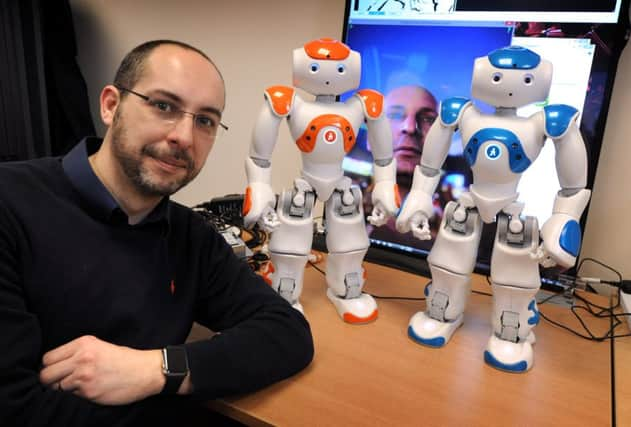FEATURE: The Hastings company hoping to change the public's perception of robots


In our very unscientific straw poll, the responses varied from ‘they’re going to get so clever they will take over the world’ and ‘they will go berserk’ to talk of The Terminator and ‘robot ninjas’.
Not one person associated robots with helping or caring.
But one Hastings-based company is hoping to change the public’s perception of robots.
Advertisement
Hide AdAdvertisement
Hide AdDigital marketing agency InFX Solutions boasts an impressive client list which includes Lucozade, City Jets, Ribena and the GSK Human Performance Lab, and also works with smaller local clients such as Walkers and the Wild Mushroom.
But in recent years the business has started to move into investigating ‘physical digital’ - including robotics.
Sitting on the desk at InFX’s Robertson Street offices are two small robots, costing £4,000 a piece.
Company director Marc Woodhead says they represent a milestone in robotics.
He said: “They are the ZX81 of today.
Advertisement
Hide AdAdvertisement
Hide Ad“The ZX81 was the first computer you could afford to buy and explore at home.
“They have reached the point where the robots are the ZX81 of this age.”
Standing 58cm tall, Nao (pronounced ‘Now’) is the first humanoid robot produced by French company Aldebaran.
He has 400 different characteristics and responds to voice commands, from walking to dancing Gangham Style, Nao’s party piece.
Advertisement
Hide AdAdvertisement
Hide AdIt is possible to find yourself feeling slightly maternal towards Nao - which I admit feels a bit odd. Perhaps it’s because his appearance is a cross between a little person and an over-sized (although very sophisticated) child’s toy.
But that is partially the point of Nao.
Marc said: “It’s the children’s reactions to it which is the most interesting thing. They are the ones who will have to live with these things.
“When we show this to children, the reaction is extraordinary. They do not fully understand it’s not alive.”
He added: “My two year old is very inquisitive. He loves the robot, was slightly nervous of it, but now he will seek its activation.
“When it walks around, he will follow it around.
Advertisement
Hide AdAdvertisement
Hide Ad“His reaction is interesting. There are no pre-conceived ideas for him.
“It’s an object that interacts with him like a sibling would.”
Nao has been used extensively in special schools in France and Japan, with autistic children reacting particularly well to the simple, yet friendly, face of the endearing bot. He has also helped autistic children to learn how to engage with people.
This fits in with Aldebaran’s mission statement - creating robots to assist humans in their day-to-day lives, in their family lives, in their leisure activities and in their work.
Advertisement
Hide AdAdvertisement
Hide AdThe company’s goal right from the beginning has been to make robots accessible to everyone, the aim being that they will become our daily companions.
The company has created two other robots - adult-sized Romeo, costing hundreds of thousands of pounds, and Pepper, four feet tall with more dexterous hand movements.
InFX Solutions, which is hoping to have its own Pepper in the future, is exploring people’s reactions to Nao and ways the robots can be utilised.
One day it is hoped the robots will be able to care for the elderly and vulnerable in their own homes - learning how to tell if a person has fallen and how to call for help.
Advertisement
Hide AdAdvertisement
Hide AdMarc said: “What Aldebaran are really focussing on is more care than anything else.
“It’s robots who can help keep people safe.
“If one of my parents was to end up on their own, with the lifestyle my brother and I have, it would be difficult for us to always be there with one parent, and that upsets me.
“These things are a potential answer to support looking after people and offer better emergency cover.”
While the robots have some human characteristics, Marc doesn’t believe they should have skin, hair or be too human like.
Advertisement
Hide AdAdvertisement
Hide AdHe said: “Personally, keeping a difference makes more sense. As a culture we have never dealt well with anything too similar. I worry for robots in that culture.”
Which links back to our crude straw poll - despite the efforts of companies like InFX and Aldebaran, people still view artificial intelligence with a sense of fear or mistrust.
Marc said: “I get the impression that perception of robots being our downfall is more amusing than thinking the other way, that they could help.”
But Marc is looking forward to a time when humans and robots can work side-by-side for a harmonious future.
He said: “I have grown up with this. I remember robots as a concept in my mind forever.
“So to see them starting to come to life and become part of our reality is very exciting for me.”